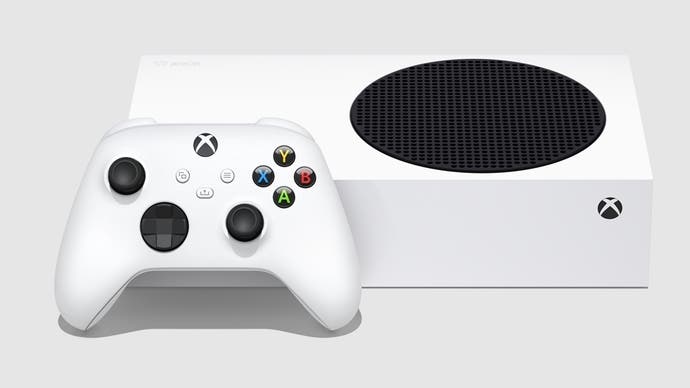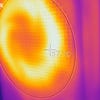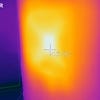Xbox Series S review: next-gen gaming on a budget - and in style
Compact discless.
Some might say that Xbox Series S is the anti-Digital Foundry console. Out of the gate, its mission statement is specifically not to deliver the state of the art in its visual presentation. Instead, the pitch is something very different - to enable next-generation gaming without having to shell out $500/£450 to indulge your hobby. Combined with Xbox All-Access, or as a standalone purchase with the value-rific Xbox Game Pass, it's a machine designed to enable access to the games of today and tomorrow without having to wait a couple of years for the latest and greatest console hardware to drop in price - something that Microsoft says may not happen anyway.
Series S delivers exactly what it sets out to achieve, but it's not an anti-DF machine, far from it. It's beautifully designed, irresistible in the flesh, and in a world of economic uncertainty and an increased drive towards sustainability, it's the most affordable and efficient next-generation machine. It certainly has its drawbacks, but it achieves what it sets out to and it does it with genuine style.
That starts with the packaging, which is attractive on the outside and does a nice job of presenting your new machine to you on the inside - a neatly wrapped console-sized parcel in the centre, accessories at the top: the same HDMI 2.1 spec display cable as Series X and a white version of the newly refined controller, plus a couple of AA batteries. Set-up is simple, made even easier by the Xbox smartphone app that interfaces with the console and takes you through all of the required inputs as the system software updates on the machine itself - a process that still seems too long and involved, and the single biggest lag factor Microsoft has not removed in the transition from one generation to the next.
Once the system has updated, it's clear to see that Series S has the same zip as its bigger brother - which is not surprising bearing in mind that both feature Zen 2 CPU clusters and NVMe solid-state storage, rated at 2.4GB/s of sequential read bandwidth. The quality of life improvements offered by Xbox Series S over its predecessors can't be understated: as I write this review, I'm attempting to copy over Gears 5 from an external SSD to the internal drive of an Xbox One X to finish off the power consumption table below - and the general slowdown and lag is truly poor. What rankles the most is pressing a button to select an option then waiting seconds for any kind of response. The Series consoles are such a huge improvement here, and that extends to all areas of the user interface. The 1080p dash is also effectively identical in terms of look and feel to Series X , and that extends to display outputs: this may be a machine better suited to 1080p and 1440p gaming, but you still get 4K 120Hz HDR output options, and the same 4K encoding media block as Series X.
Xbox Series vs PS5 specs comparison
All of which leads us - inevitably - to the specs comparison and the question of economics. Series S features the same Zen 2 CPU core as Series X, running with a 200MHz deficit, which Microsoft told us is mostly about product differentiation, but does feel like a cut that need not have been made. The GPU is also of the same class as Series X, simply smaller. The premium product's 52 AMD RDNA 2 compute units shrink down to just 20, with clocks reduced too, giving us 4TF of GPU compute up against the 12.2TF of the bigger machine. Memory allocation drops from 16GB down to 10GB, with eight gigs available to titles (vs 13.5GB on Series X). Memory bandwidth is also squeezed significantly, with 560GB/s on X cut back to 224GB/s on the S.
It's worth stressing that while these cutbacks seem - and are - severe, all of the key features of Series X are present. The GPU is smaller, but it is still using the full RDNA 2 specification, it does feature variable rate shading, hardware accelerated ray tracing, mesh shaders and texture streaming optimisations via shader feedback sampling. It's all there in terms of UI functionality too: Quick Resume is supported for swift access to the exact point you left off in your last played games (though this was not working correctly in the review period - something Microsoft is racing to fix). Superficially, you won't notice any cutbacks to the Series X experience - bar the resolution cut when you start your games. But where the cuts are visible, the value proposition starts to lose some of its sheen.
It starts with the SSD - advertised as 512GB, but giving you just 364GB of useable space. In a world where the 1TB expansion storage card (useable space: 902GB) costs almost as much as the console, this presents a problem in an age where more and more games are breaking the 100GB barrier. It's undoubtedly an issue, but it is worth remembering that 40-50GB is more the average. Older Xbox games can run from just about any USB storage device you care to attach but the point is that whether it's for next-gen gaming, or for archiving titles, you're going to hit the limits of Series S's SSD sooner rather than later and you'll be paying more for extra storage. The second major issue is the all-digital nature of the product, which severely limits where you can buy your games and how much you pay for them. Of course, this is offset to a certain extent by Xbox Game Pass, with its mind-bending value proposition. It's been described as the best deal in gaming and that's difficult to argue with.

| Xbox Series X | Xbox Series S | PlayStation 5 | |
|---|---|---|---|
| CPU | Eight-core AMD Zen 2 - 3.8GHz/3.6GHz (SMT on) | Eight-core AMD Zen 2 - 3.6GHz/3.4GHz (SMT on) | Eight-core AMD Zen 2 - variable clock up to 3.5GHz (SMT on) |
| GPU | AMD RDNA 2 - 52 CUs at 1.825GHz (12.2TF) | AMD RDNA 2 - 20 CUs at 1.565GHz (4TF) | 'Custom' AMD RDNA 2 - 36 CUs at up to 2.23GHz (up to 10.3TF) |
| Memory | 16GB GDDR6 - up to 560GB/s bandwidth | 10GB GDDR6 - 224GB/s bandwidth | 16GB GDDR6 - 448GB/s bandwidth |
| Storage | 1TB SSD - 2.4GB/s uncompressed bandwidth | 512GB SSD - 2.4GB/s uncompressed bandwidth | 825GB SSD - 5.5GB/s uncompressed bandwidth |
| Useable Storage Space | 802GB | 364GB | 667GB |
| Optical Drive | 4K UHD Blu-ray | No | 4K UHD Blu-ray (not on Digital Edition) |
| Price | $499/£449 | $299/£249 | $499/£449 (Standard) $399/£359 (Digital) |
Xbox Series S: power consumption and thermal analysis
The Xbox Series S is the least powerful system in the next generation line-up, so it makes sense that it draws the least power. The cut-down Series system on chip (SoC) has 55 per cent of the silicon area of the Series X, but it's more efficient than that under load - presumably owing to the reduced frequencies on the CPU and GPU. In the table below, you'll see the power consumption of both SKUs in the current-gen and next-generation line-up and outside of gaming, power consumption is very similar comparing One S to Series S and likewise with the X models.
I chose Gears 5 for the gaming test as I've found this title to be far more demanding on power than anything else in the Series line-up, and these peak power draw metrics account for the highest system load from the first chapter of the game. Here we see that Series S requires 13 per cent more power than One S (which is limited to 30fps) for an almost 3x increase to GPU performance and 4x on the CPU. It really does seem like the junior Series console is hitting the sweet spot in terms of overall performance per watt. Meanwhile, Series X requires 23 per cent more juice over its predecessor. One thing to bear in mind here is that Gears 5 truly is demanding. My other Series S titles drew 10W less from the mains.
The thermal photography throws up some fascinating results. Likely owing to its much smaller form factor, Xbox Series S is actually the hottest next-generation console. This is perhaps not surprising when considering that it is on par or more demanding on power than Xbox One S, which enjoys a much larger form factor. With that said, the construction of Xbox Series S is simple but effective: a large fan sits on top of the main processor, expelling air directly out of the large, circular black vent. In my tests, this hit a maximum of 67 Celsius - higher than both PS5 and Series X maximum temperature points. However, the machine is just as whisper quiet as Series X.
| Power Consumption | Xbox Series S | Xbox Series X | Xbox One X | Xbox One S |
|---|---|---|---|---|
| Power Off | 0-1.5W | 0-2W | 0.5W | 1.5W |
| Instant On Standby | 16W | 29W | 39W | 11W |
| Dashboard | 25W | 42W | 48.5W | 22.5W |
| Gears 5 (Peak) | 82.5W | 210W | 173W | 73W (30fps) |
- Microsoft tells us to expect optimisations to instant-on power consumption on Series X soon.
Series S gaming: does the 1440p marketing hold up?
This is the crucial factor. In principle, I see nothing wrong with the notion of bringing two consoles to market separated by their GPU power (although the clock differential on the CPU is harder to justify - why give developers anything more to worry about?) and Microsoft's pre-release marketing suggested that what Xbox Series X delivers at native 4K resolution, Series S will be able to match at 1440p. The messaging suggests only good things: if you're on a 1080p screen, 1440p rendering gives you a nice level of super-sampling anti-aliasing, improving image quality. Meanwhile, four years of PS4 Pro gaming has taught us that even if 1440p isn't exactly ideal, it still looks a fair bit better than 1080p when delivered to a 4K display.
The problem with this marketing is straightforward enough: games incur different rendering demands on different hardware configurations, something I verified back in March when I put together an AMD RDNA 4TF PC and stacked it up against higher-specced equivalents closer to PS5 specification. So, on the one hand, we have Gears 5 which sees the Coalition broadly achieve Microsoft's spec claims - though even this is difficult to verify owing to the use of dynamic resolution scaling on both X and S consoles. Elsewhere though, the claim holds less water. Forza Horizon 4 hits native 4K on Series X, but only 1080p on Series S - and it's the same story with Sea of Thieves. In effect then, Microsoft's own studios don't fully back up the platform holder's marketing.
My problem is not with the machine, however, but with the messaging - because if there is indeed feature parity between Series X and S at 4K and 1080p respectively, that's fine. That's certainly what's happening with Forza Horizon 4, and there are actually some rather lovely surprises elsewhere. Ori and the Will of the Wisps - one of the most beautiful games in the Xbox library - runs at 4K60 or alternatively at 1080p120. It does so flawlessly. Meanwhile, the Touryst runs at the same 4K60 as Xbox One X. However, on the flipside, Watch Dogs: Legion may well retain hardware accelerated ray tracing and very stable 30fps performance, but the reductions in texture quality, shadow quality and much more are clearly apparent. It also highlights another issue: if 4K Series X equates to 1080p Series S in some cases, what happens when X uses dynamic resolution scaling? In the case of Watch Dogs: Legion, it seems that the DRS range is 900p-1080p up against 1440p to 2160p on Series X - and as the direct screenshot comparisons on this page demonstrate, that can be an issue when blown up on a large living room display.
We only have a limited number of titles to test so far, but for the most part, the Xbox Series S holds up as a cheap, entry-level console and if you go in expecting a lower-resolution version of the Series X experience, that's what you're going to get - but there is the sense that the long-term prospects of the machine will be very much related to just how scalable it really is, and how it continues to be as the generation progresses. There also appears to be some level of elasticity in which features translate between the two consoles. Watch Dogs: Legion retains hardware-accelerated ray tracing features, while they are absent in Devil May Cry 5: Special Edition, which suggests that the extent of the scalability between the two systems isn't quite so cut and dried. On top of that, a game launching with RT features on one console and not on the other (at launch, no less) suggests that in terms of technical requirements from the platform holder, Microsoft will have signed off on that.








Ultimately, I believe the quality of Series S releases will come down to developer buy-in and general enthusiasm for the system. Towards the end of the outgoing console generation, time and again we heard from studios of the issues they had working with Xbox One S - and this was clearly reflected in the final quality of many of the games we tested. There are some comparisons here with Series S - but only to a certain extent. There is much more commonality between the two new consoles than there was between One S and One X, and the conversion work should be easier. Again, my key concern isn't really about the pared back GPU power of the Series S - more the seemingly savage 5.5GB drop in available system memory for titles.
Of course, Xbox isn't just about the games of tomorrow, it's hugely invested in legacy support, and an aspect of the Series S that cannot be overlooked is its backwards compatibility support. It's good, but it varies dramatically from Series X and indeed PlayStation 5 in one key respect - it runs and enhances Xbox One S versions of legacy games, not Xbox One X (or PS4 Pro, in the case of PS5). What this means is that most of the transformative improvements we documented in previous back-compat coverage will not transfer onto Series S as they were mostly based on 4K titles that offered the option of an unlocked frame-rate - fertile ground for unleashing extra CPU and GPU power.
With Series S, what you're getting are more refined versions of Xbox One S titles, most of which targeted 30fps instead. Unless Microsoft or the developer intervenes, nothing more can be done. We've seen a demo of Fallout 4 running at 60fps using a double fps technique the compatibility team has developed - I'd love to see more here, but certainly during the review phase, Xbox Series S ran the game at 30fps. It sums up most of the improvements you'll see overall: the same visual feature set as Xbox One S, but with 16x anisotropic filtering and a dead-on lock to the developer's original performance target. But to be clear, what Xbox Series S cannot do is break the 900p resolution limit that so many One S games operated at.
There are some positives on the compatibility side. Xbox One X enhanced versions of Xbox 360 titles are still enhanced, with a 2x2 resolution multiplier vs the 3x3 boost seen on One X - a native 720p experience scales up to 1440p instead of 4K then, which is better than I expected. Also, Xbox One X and even One S could outperform the CPU limitations of original Xbox 360 hardware, but there were still some issues in select titles - Series S effortlessly sorts that out. Meanwhile, there are promising signs on the OG Xbox side of things too. Star Wars: Republic Commando runs locked at 60fps, for example, effortlessly outperforming Xbox One X, which could drop into the 40s. Really though - for the best way to experience legacy titles, especially from the Xbox One era, it's the Series X that's the better choice. Meanwhile, PlayStation 5 is similarly well equipped for boosting the experience of PS4 and PS4 Pro games.








The wrap-up: a different kind of next-generation console
In many ways a contentious product, Xbox Series S is definitely a great idea - and perhaps the right console at the right time. If you're not a hardcore gamer and you're looking for a 'Game Pass machine', this is a brilliant offering - there's enough space out of the box for handling a smaller selection of titles, and the lack of an optical drive isn't really an issue. Similarly, if you've purchased PS5 but you're interested in Game Pass or Microsoft's first-party wares, you can buy a Series S knowing that the subs offering is still potent, and that Microsoft's first-party wares will be expertly handled in their transition to the lower powered console. And despite so many seemingly brutal cuts to the core specification, I had a great time playing games on it - yes, there are compromises, but I think anyone buying the machine will go in knowing that they won't be getting the absolute state of the art.
But yes, for the more traditional core gamer, perhaps less wedded to the idea of a games subscription service, Xbox Series S is less compelling. If you want a decent array of titles instantly available for play, you're going to need to buy additional storage - and that's expensive enough to make the extra £110 required to buy a PlayStation 5 Digital Edition seem like quite a good deal. Not only do you effectively double the storage, but you're getting a far more potent machine. But this does assume that you'll be able to find a Digital Edition console for purchase, of course. We can safely assume that Sony loses money on the fully enabled PS5 and its losses will be even more considerable on the digital-only model - which strongly suggests that far fewer of them will be made.
That's the rational assessment of the Xbox Series S proposition - but I'll end this piece by talking about something important that I can't quite put my finger on. I first saw the console in the flesh at the Microsoft campus back in March - and I instantly loved it. The form factor is simply irresistible, the design is nigh-on perfect. There's always been a certain degree of desirability attached to miniaturised consumer electronics and Series S taps into that more than any other recent technology product I can think of. Perhaps it is indeed all about how small the machine is, or perhaps it's how Series S is so reminiscent of how consoles used to be in terms of form factor and overall 'bang for the buck'. I honestly don't know.
Series S's charms grow even more appealing when stacked up against the larger, more powerful but somewhat inconvenient consoles it launches alongside. The new entry-level Xbox is a brilliant-looking product that easily goes anywhere (even on holiday - when that's allowed again!) and looks great doing it. Coming out of that initial reveal and discussing the product (recorded for posterity here), John Linneman and I should have been griping about the spec cuts, the added burden for developers and of course, the all-digital nature of the machine. Instead, primarily, we were enthusing about the form factor and how cool the machine looks and feels. Whichever way the next console generation goes, one thing is clear: Microsoft knows how to design and build brilliant console hardware.









